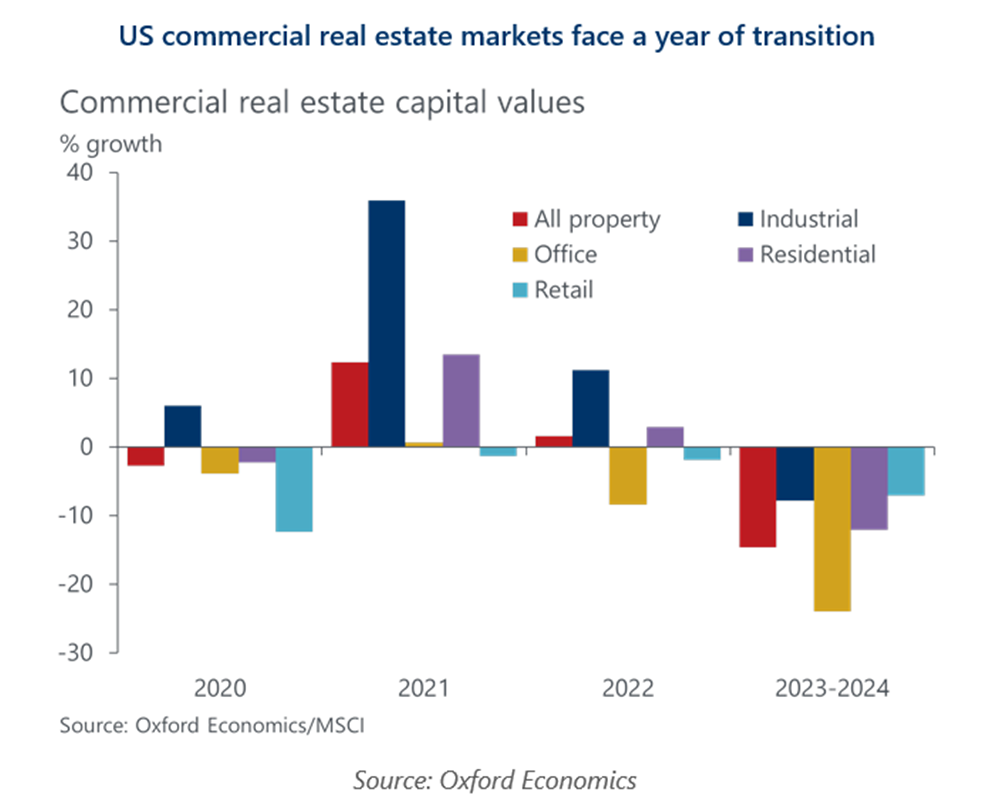Blog | 04 Apr 2024
Navigating the US Economic and Real Estate Transition

Innes McFee
Managing Director of Macro and Investor Services


This year is set to be a turning point for commercial property markets in the US. A gradual easing in inflationary pressures alongside a steady, if unspectacular, year for GDP and employment growth should help to ease the market through the final leg of the post-COVID adjustment.
During my recent keynote presentation at the NCREIF 2024 Spring Conference in Phoenix, Arizona I shared four important themes market participants will need to understand to navigate the short and medium term successfully.
In this blog I shall delve into these four areas which are likely to have a bearing on returns, funding markets and the differing demand by property types.

Can we expect rate cuts in 2024?
Despite current speculations and recent inflation showing a modest re-acceleration, as well as growth in the economy remaining resilient despite higher interest rates, we don’t think it likely that the Fed will refrain from cutting rates until next year.
Global supply chains continue to normalise and remain consistent with ongoing goods price disinflation, at least for the next few months. Commodity prices also seem to have settled at higher levels, implying falling inflation, and although consumer prices are concentrated in the service sector are rising, recent surges in productivity and declining wage growth point to lower services price inflation ahead.
Considering the expectation of returning to 2% inflation, three reasons support the potential for the Fed to cut rates. Firstly, the time for monetary policy to impact the real economy has lengthened, necessitating prompt easing to prevent further economic slowdown and potential undershooting of the inflation target. Secondly, even if the Fed reduces rates by 75 basis points this year, monetary policy would remain restrictive, above levels considered neutral. Thirdly, the substantial reduction in fiscal policy stimulus compared to the previous year is anticipated in 2024, potentially facilitating the Fed’s control over inflation.
Can AI lift the long-term outlook?
The US is likely to be at the forefront of adoption of Generative AI, and it will drive a wedge between real estate returns and economic growth. The economic gains will come slowly over the next decade, and it could significantly raise the outlook for US GDP, but this will be driven by productivity rather than employment.
This growth will be accompanied by a reduction in demand for some types of space ¬– most notably office, but also life sciences and manufacturing as these areas have the highest exposure to generative AI.
Is globalisation over?
Although geopolitics may seem somewhat academic in the highly localised world of real estate, the magnitude of changes to domestic and international politics make it a factor shaping the outlook for real estate markets.
US and China decoupling is shaping domestic policies. Regardless of the outcome, the upcoming presidential election is likely to shape US domestic policies (through subsidies or tariffs) to see increased demand for industrial space as it seeks to replace parts of the global supply chain, with foreign investment into US real estate set to remain weak.
Is it a new era for inflation and rates?
A persistently higher inflation regime would have profound impacts on real estate returns as well as other asset classes and the relationships between them. Currently financial markets are pricing in approximately a 30% chance that inflation will still be 3% or above in 5 years’ time but we think those odds are too high because a high proportion of the recent surge in inflation can be explained by excess demand.
But we are more cautious when it comes to the volatility of inflation. The pre-pandemic economy was unusual for its low and stable inflation rate, with the 20 years leading up to the pandemic being the lowest and most stable periods of inflation over the past 700 years. Whilst the simple law of averages would suggest the future is set to be more volatile, geopolitics and the disruptive influence of generative AI also point in that direction. And if we do see more volatility, we expect central banks to react more swiftly to nascent signs of inflation in the future.
The recent collapse of the Baltimore Key Bridge is another reminder of how adverse supply shocks can also become more frequent as narrowing global supply chains place more emphasis on key assets.
The key lesson for real estate markets is that interest rates may be more volatile in the future.
Author

Innes McFee
Managing Director of Macro and Investor Services
+44 (0) 203 910 8028

Innes McFee
Managing Director of Macro and Investor Services
London, United Kingdom
Innes McFee is the Managing Director of Macro and Investor Services, based in London. Innes oversees the activities of the Macro & Investor Services teams globally, including the Global Macro Forecast and Global Macro Service.
Innes joined Oxford Economics in 2017 after 6 years at Lloyds Banking Group as a Senior Economist. At Lloyds Innes was responsible for the economic scenarios underpinning the Group’s internal planning and stress testing; analysis of key risks; and developing Lloyds’ approach to multiple economic scenarios for IFRS9. In addition, Innes’ role included developing the Group’s capability in modelling macroeconomic fundamentals and UK banking markets and advising the Group Corporate Treasury on financial market developments.
Prior to joining Lloyds Innes was an Economic Advisor at HM Treasury where his roles included management of the UK’s foreign currency reserves; US economist; and G20 macroeconomic policy advisor. Innes has a first class undergraduate degree in Economics from the University of Durham and a MSc in Economics from Warwick University.
Tags:
Related Reports
Click here to subscribe to our real estate economics newsletter and get reports delivered directly to your mailbox

Real Estate Trends and Insights
Read more analysis on real estate performance and location decision-making.
Read more: Real Estate Trends and Insights


